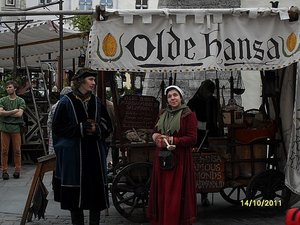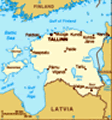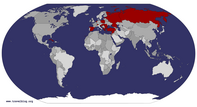Advertisement
Published: June 21st 2017

 Old town - Olde Hansa
Old town - Olde Hansa
http://www.oldehansa.ee/The long weekend started on the 14th of Oktober on Weeze airport, heading to Tallinn. (tank you Ryanair for this opportunity) Both of us we were sleepy. We woke up at 4 o clock as Weeze airport is quite far away. And if we have to consider that we might to end up at the rush hour in the morning it's wise to leave early.
It was our 3rd time that we were flying with Ryanair so we were not surprised about the conditions. 😊 From Weeze to Tallinn it took 2.5 hours by plane. Once arrived to Tallinn airport we took a taxi to our hotel. The location of the hotel was very close to the old town, so most of the visits could be done by feet.
After check in and putting our luggage in our room we went outside for a short orientation. Outside the old town, at the streets behind our hotel, we had the feeling that we were walking in the USSR. Buildings are grey and a bit impoverished. But in a certain way it has its own charm.
By crossing the central station and the big road, we approach
one of the gates of the old town. When we entered the old town, the Sovjetic style changed into a fairy tale. The local authority did everything to keep the old town attractive.
The town wall and watch towers are surrounding the old town. We arrived to the main square and decided to take a cup of coffee at one of the nice looking terraces. From there we noticed some people who were medievally dressed. When we walked to them we noticed that they belong to a restaurant with a medieval theme, called the olde hansa. When we looked inside the restaurant and the grocery shop of the restaurant, we realised that the locals really made work of tourism. Only one word: FABULOUS!
We chatted with one of the employees about the nice restaurant and perhaps some tips about the city trip. We learned that the place where we were at the moment was called: All-Linn, which means "Lower Town" and that this area is one of the best preserved old towns in Europe.
The area which is built on the hill is called Toompea, which means Upper Town. That area was once a separate town, the

 Old town - path to Toompea hill
Old town - path to Toompea hill
Old town - path to Toompea hillresidence of the Chivalry of Estonia, Roman Catholic bishops of Tallinn and Lutheran superintendents of Estonia, occupying an easily defensible site overlooking the surrounding districts.
We agreed that today's dinner will be at the olde hansa. We continued to orient the town and went one by one trough our to-do list.
A must is to go up to the city wall. It is an opportunity to get a glimpse of the town's Medieval defence. From the city walls you can enter the watch towers. The Hellemann Tower, 3-storey tower dates back to the 14th century and at different times was used as a prison and a weapons store. These days it is housing an art gallery.
Another famous tower is Kiek in de Kök. The name of this tower literally means "Peek into the Kitchen." It was so high that Medieval guards joked they could see right down the chimneys and into the kitchens of the houses below. The tower was originally built in the 1470s, but quickly expanded and strengthened, giving it walls that were 4m thick. During post-war repairs, a row of four cannon balls was placed in the newly patched stone wall as a
memorial. You can still see them on the tower's southeast side
From the All-Linn we took the picturesque walkway - stairway combination to Toompea. Off course it is uphill, but who's in a hurry? Just stop in front of every gift shop or a small break at a cafeteria and in the end, we reached Toompea.
Even if it was only for the view, Toompea is a must for a Tallinn city trip. From here you have a nice overview from the Kohtuotsa viewing platform to the Lower Town. Another attraction is the Toompea Castle consisting of the Russian empire governor's palace, walls and towers of the medieval fortress, the expressionist parliament building. The facade of the classicist governor's palace dominates Lossi plats ("Castle square"), where the Orthodox Alexander Nevsky Cathedral overtops it. The cathedral, nowadays the main church of the Estonian Orthodox Church of Moscow Patriarchate, has become for tourists somewhat of a symbol of Tallinn due to its exotic look, while the opinion of Estonians about it is rather ambiguous.
When we take the path back to the Lower Town we saw two medieval archers. Another touristic attraction. They were showing techniques of archery. For
a small fee they are offering a training.
Back at Lower Town we decided to have a rest at the hotel, as we are awake since 04:00 and a bit tired of the travel. We had also the intention to explore the nightlife of Estonia so for sure we needed a break and headed to the hotel.
After a nap, when we woke up, it was slowly time for dinner. As planned we headed to the old town to try out the most attractive restaurant of the town, the Olde Hansa. We had no idea what we could expect of the food in this country. Sure it could not be worse than the Dutch kitchen 😊 .
We arrived at the medieval restaurant. Only to taste the atmosphere is a reason enough to have a dinner at this place. From in and outside it was decorated with a medieval theme. The light inside were all chandeliers with candles. The staff all dressed in medieval costumes. Wooden tables, stone mugs. Having dinner here is more an attraction then just having a dinner.
We ordered the main dishes and tried out the house wine. Unfortunately the house wine
was not matching with our tastes. It was tasting like wine with cinnamon. It tasted 'different' but I can not say that I enjoyed it. When the main dished came, we were completely in a culture shock! The meat was well prepared and very tasty, but the side dishes were not making any sense at all. Meat with marmalade, boiled sugar beets, rice with sugar? These combinations are not compatible at all with our South European taste for food. Anyway we finished the main dishes (without the side dishes) and prepared us for the nightlife of Tallinn.
Outside the restaurant there was a man trying be the fire master, by playing with sticks on fire and spitting fire. During his interesting show he slipped and fell and nearly caught fire. I think it was more the effect of the petroleum which he has in his mouth the whole evening.
Time for the nightlife! Initially we went to a nice bar with live music, Gusto bar. Nice place, nice music. reasonable price. Nice for lounging. Afterwards we found a real beerhouse. A big bar with all kind of beer. After some drinks and enjoying the nice atmosphere it was
time to return to our hotel and say goodnight to Tallinn.
DAY 2 We woke up and prepared for the breakfast. We were wondering how the breakfast was in this Economy hotel and soon we realised that we should go to the bakery next door. The choice was quite minimal and there was not much which matched our taste. No problem at all if we look to the price we paid for the hotel and the bakery next door had a lot of nice things for breakfast.
When we collected new energy it was time to continue. Today the Estonian Open Air Museum was on our schedule.
From the city centre we took the bus. It took approximately 15 minutes until we arrived to the gate of the Estonian Open Air Museum. The Museum is an akin to a village. A forest with farms, windmills and even its own church. Unfortunately we came on a wrong date and there were no shows or festivals. Normally the farms are occupied by 'farmers', who are employees of the museum and there were activities to do. For us it was only walking and enjoying of the nature.
The
museum visit took approximately 1.5 hour. We bought some nice souvenirs from the museum shop and took the public transportation (bus and trolly), which dates from the Sovjet time, to the city centre.
We saw already the most part of the old town, but we didn't went outside the old town yet. From the station we walked trough the old town to the shopping area. On de way we took some looks in the souvenir shops. We noticed that there were many shops selling products made from amber. From this we learned that the Baltic region is the largest known deposit of amber.
We left the old town via the Viru Gate, a picturesque gate with 2 watchtowers, and walked to the economic centre of Tallinn. Outside of the old town, it is just like another big city. While we were walking, suddenly we found a traditional Turkish baklava chain, called Gulluoglu. This chain originates from south east Turkey and it was very funny to find this chain in Estonia. We entered to eat some sweet baklava. When the owner realised that we were Turkish too we had a nice conversation. He used to work in Russia and

 Freedom square
Freedom square
In summer of 2009 the residents of Tallinn were given back a vital piece of their city's heritage: Freedom Square (Vabaduse väljak). From the last days of the Tsars and through Estonia's first period of independence, this open area at the edge of Old Town had been a place of national symbolism and civic pride, as well as a favourite public gathering spot.since 2 years he was running this place. Beside of selling baklava it was also a small restaurant. Perhaps a good idea to try it out for an evening.
At the end of the afternoon it was time for our day break and went to the hotel for a nap.
This evening we wanted to have a dinner according our Mediterranean taste. In the old town we saw a Greek restaurant, so choice was made very fast. Meet, lamb chops and tzatziki. Always a good choice. 😊
After the delicious dinner we walked again trough the old town. Everything is so beautiful that it doesn't matter if we saw it already once. But This evening we realised that we missed one of the highlight to see. The Katariina käik. (St. Catherine's passage)
Easily the most picturesque of Old Town's lanes, St. Catherine's is a narrow walkway along the
back of what used to be St. Catherine's Church.
What makes the passage particularly interesting is that it's home to the St. Catherine's Guild, a collection of craft workshops where artists use traditional methods to create and sell glassware, hats, quilts, ceramics, jewellery, hand-painted silk and other
wares. The workshops are housed in the small, 15th- to 17th-century rooms on the south side of the lane, and are set up in an open-studio fashion so visitors can watch the artists at work, be it glass-blowing, weaving or pottery making.
As absorbing as these displays can be, St. Catherine's Passage is more about ambience than anything else. No other place in Tallinn combines creativity with a Medieval atmosphere quite like it.
This evening we visited some other pubs. There were some nice and cozy ones, but we ended the night at Gusto bar. This night was a salsa night.
DAY 3 Today we had some museum visits on our mind. One of the recommended museums was the Estonian Museum of Occupations. The location of the museum was just a bit outside the old town and reachable by foot. Close to the Museum we arrived to the Freedom Square.
This square is a sophisticated place to relax, filled with benches and cafés, and faced by two art galleries. Most of all this is one of best places to see evidence of the city's 1930s-era building boom, with art-deco and functionalist buildings flanking two sides
of the square. The large pillar with the cross that dominates the west side of the square is one of its new features. This is the Monument to the War of Independence, commemorating Estonia's hard-fought struggle in 1918 – 1920 to free itself of foreign rule.
To get a glimpse of the square's older history, all you have to do is look down. A glass panel in the street on the northwest corner of the square reveals the foundation and stairs of the Harju Gate tower that stood here in Medieval times. Even more historic information can be found in the new AHHAA Science Centre tucked into the underground gallery on the opposite side of the square.
From there we went to the Estonian Museum of Occupations.
Due to the unluckily location of Estonia it was many times under occupation.
The most recent history is that Estonia became an independent country in 1921. Unfortunately this independence didn't last long. In 1939, after an agreement between Hitler and Stalin, that they would not attach each other but occupy the land between them, Germany Occupied Poland and the Baltic Republics, including Estonia, became a part of the USSR.
As Hitler didn't honoured his commitments, in 1941 Germany attached the USSR and occupied the Baltic Republics. When Estonia was 'liberated' from the Germans by the Red Army in 1944, it was a new start of another occupation.
Estonia continued as a part of USSR until 1991. After the USSR was collapsed, Estonia became after 70 years of occupation independent again.
The last museum on our list, but the most interesting one. Hotel Viru, aka KGB museum. We entered hotel Viru and together with the rest of our group we waited to our guide. Finally when she arrived, we took the elevator to the 22nd floor to start the tour.
When the USSR became accessible for tourists, the state had to control that foreigners were not in touch with the local citizens. Tourists were only allowed to stay at hotels which were approved by the government. Hotel Viru was one of those. The hotel had the highest quality of everything, just to give the foreigners a good perspective about USSR. The good perspective was not the only reason for these kind of hotels.
The real reason was located at the 23rd floor, which was not
accessible. Officially it was a technical room and because of security reasons, like strategic places are visible from this floor (like the airport), it was not accessible. (A real Sovjetic statement as the view from the restaurant at the 22nd floor is the same)
On the 23rd floor was the headquarters of the KGB located. We took the stairs to the 23rd floor to have an impression about the KGB day to day business. The location was important due to strategic reasons. It had a direct communication line with Moscow and the Sovjet Embassy in Helsinki was reachable via the HF radio.
The foreign guests were al spied by hidden microphones in the rooms. Everything was to avoid that foreigners were not in touch with the local citizens. Interesting that the Sovjet system, where the state was afraid of the people, and the people were afraid of the state, could withstand as long as it did.
Finally we entered the radio room. Some stacks of metal cases with black knobs and dials look like something from a 1950s sci-fi movie were left over since the KGB left the building in 1 night after the independence of Estonia.
As an extra for this interesting trip, we got free tickets for the night club of the hotel.
In the evening after our rest we decided to have our dinner at the Turkish place, (Gulluoglu). As it was one of the less Turkish places in Tallinn, most of the Turkish citizen of Tallinn were coming here for lounge and dinner. We saw a group and had a short chat with them. Later we realised that were the ambassador and the Embassy staff. 😊 Time passed while enjoying the food and listening to the life story of the owner.
It was our last night and before we go to sleep we wanted to go for clubbing and as we thought, the night ended at Gusto's bar.
As there is a time for coming, there is also a time for going. After checking out from our hotel we took the tram and headed to the airport, to fly back to home...
Advertisement
Tot: 0.07s; Tpl: 0.014s; cc: 11; qc: 26; dbt: 0.0261s; 1; m:domysql w:travelblog (10.17.0.13); sld: 1;
; mem: 1.1mb















